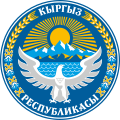1990 Osh clashes
| Osh riots | |||||||
|---|---|---|---|---|---|---|---|
| |||||||
| Belligerents | |||||||
|
Uzbek rioters
|
Kyrgyz rioters
| ||||||
| Casualties and losses | |||||||
| 300-600 deaths (official estimate); 1,000-10,000 (unofficial estimate) | |||||||
The Osh riots (
Historical background
Prior to the Soviet period, the inhabitants of the
By the late 1980s, the economic situation between both Kyrgyz and Uzbek populations had markedly noticeable differences. Uzbeks, who were traditionally the merchants and farmers of the region, benefited from the market conditions of the
In the late 1980s, several inter-ethnic disputes had already plagued the Fergana region. Around June 1989 in the neighboring
Riots
The violence began on 4 June in the city of
During the riots some of the local militsiyas (the local Soviet police force) expressed loyalties to their own ethnic counterparts by taking part in the riots.[8] Although supplies and vehicles used in the attacks were predominantly stolen by the young rioters, some local Kyrgyz elites who did not openly take part in the violence lent supplies and vehicles to the demonstrators.
The worst of the large-scale clashes occurred in the cities of Osh and
In
Official estimates of the death toll range from over 300
Aftermath
In the 1991 trials conducted by the new independent
With the 1991 independence of Kyrgyzstan, Uzbeks were not ensured much autonomy in the new government of
A stone monument commemorating the riots was erected in the field where they ignited, with plaques in Russian, English, and Old Turkic.[20]
See also
References
- ^ a b c d Lubin et al., p. 47.
- ^ Recknagel, Charles (24 June 2010). "Ferghana Valley: A Tinderbox For Violence". Radio Free Europe/Radio Liberty. Retrieved 17 July 2010.
- ^
Kaplan, Robert D. (1997). The Ends of the Earth: From Togo to Turkmenistan, from Iran to Cambodia – a Journey to the Frontiers of Anarchy. Vintage Books. ISBN 978-0-679-75123-6.
- ^ Lubin et al., pp. 45–49.
- ^
Luong, Pauline Jones (2004). The Transformation of Central Asia : States and Societies from Soviet Rule to Independence. Ithaca: Cornell University Press. pp. 154–46. ISBN 978-0-8014-4151-6.
- ^ Razakov, p. 77.
- ^ Razakov, p. 81.
- ^ Tishkov, p. 133.
- ^ Tishkov, p. 136.
- ^ Tishkov, p. 138.
- ^ Tishkov, p. 139.
- ^ ШУСТОВ, Александр (2 February 2008). "Межэтнические конфликты в Центральной Азии (I)" (in Russian). Archived from the original on 15 September 2008. Retrieved 25 October 2008.
- ^ Solvang, Ole; Nesitat, Anna (16 August 2010). "Where is the Justice?" Interethnic Violence in Southern Kyrgyzstan and its Aftermath". Human Rights Watch.
- ^ a b "Report of the Independent International Commission of Inquiry into the Events in Southern Kyrgyzstan in June 2010" (PDF), The Independent International Commission of Inquiry (KIC), 3 May 2011, retrieved 24 April 2013
- ^ "Pogroms in Kyrgyzstan" (PDF). International Crisis Group. 23 August 2010. p. 1. Archived from the original (PDF) on 3 April 2012. Retrieved 8 October 2012.
- ^ Tishkov, pp. 134–135.
- ^ Lubin et al., p. 49.
- ^ Ismailbekova, Aksana. "The glimmer of hope in bloody Kyrgyzstan". Fergana.news. Retrieved 12 May 2011.
- ^ Liu, Morgan (2012). Under Solomon's Throne: Uzbek Visions of Renewal in Osh. Pittsburgh, PA: University of Pittsburgh Press.
- ^ Liu, Morgan (2012). Under Solomon's Throne: Uzbek Visions of Renewal in Osh. Pittsburgh, PA: University of Pittsburgh Press. p. 23.
Sources
- Lubin, Nancy; Martin, Keith; Rubin, Barnett R. (1999). Calming the Ferghana Valley: Development and Dialogue in the Heart of Central Asia. New York, NY: The Century Foundation Press. ISBN 978-0-87078-414-9.
- Tishkov, Valery (May 1995). "'Don't Kill Me, I'm a Kyrgyz!': An Anthropological Analysis of Violence in the Osh Ethnic Conflict". Journal of Peace Research. 32 (2): 133–149. S2CID 110098211.
- Razakov, Talant (1993). Ошские события: На материалах КГБ (The Osh Events Based on KGB Materials) (in Russian and Kyrgyz). Bishkek: Ренессанс. ISBN 5-85580-001-6.

